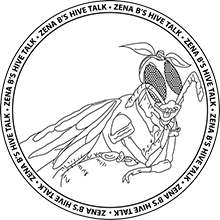Hive Talk - March 2021
Hive Talk March 2021

Hive Talk - March 2021 Spring is definitely around the corner! Both hives have survived, so far, and are taking their ‘cleansing flights’. Cleansing flights are an opportunity to defecate outside the hive, as they do not do this in the hive during the 5 - 6 months of winter. (Unless there is a ‘chinook’ and temperature warrant a quick flight. Phew! This is the critical time of the year where the older ‘winter’ bees are spent after keeping the hive’s temperature regulated and their queen safe, for 5-6 months. They will be replaced by younger nurse bees that have been hatched in mid February. It is a tipping point to where a balance is created to ensure there are enough nurse bees to take care of the brood and increase the population. This is the time when they will survive, or collapse. Of course there are several factors that contribute to colony collapse, but this fine balance is only one of them.
One of the most common ‘buzz’ words associated with honey bees is the “Waggle Dance”. There were 3 other ways of communication that the bees perform in the hive to control their activity associated with the nectar, pollen, and propolis collection? I recently ‘zoomed’ in a meeting with the Calgary Bee Club which featured the studies of Dr. Tom Seeley. Dr. Seeley has been studying Honey Bees for most of his academic career and has discovered three more ways of communication that the bees do in the hive during the collection of food sources during the warmer months. Reference: “The Bee Colony as a Honey Factory by Tom Seeley “ Shake and Wake” - Forager bees sleep at night. After an exhausting day of flying miles collecting nectar and pollen, at night they sleep. A forager/scout bee will go out in the morning, find a food source, and return to the hive only to see that her sisters are sleeping. The “early bee” will go through the hive and grab bees by their back and shake them awake and get them excited to start their day. Once the first bee, or group of bees, do this then the Waggle Dance is performed to give the sleepy bees direction to find the food source. “Waggle Dance” - Is performed by the forager bees once they discover a food source. They will fly back to the hive and perform this ‘dance’ which entails waggelling their abdomen forward then turns to the left in a small circle, waggle straight and turns to the right. Continuing this until the rest of the foragers understand that the food is a certain distance from the hive as well as direction to fly; how many degrees are angled from the sun. “Tremble Dance” - Just as it sounds. The tremble dance was mistakenly labeled as some neurotic condition that honey bees have when they are sick. Not so, the tremble dance is done when there is an abundance of food being brought in and there are not enough food storers in the hive to take on this influx of food. The tremble dance is done by a forager to tell the other bees in the hive to change their job duties to become food storers until the ‘nectar flow’ is more manageable. “The Beep” - After the tremble dance, and food is being effectively stored without delays, there are some bees that start doing the waggle dance too early. The hive is trying to keep up with incoming food, and don’t need additional input at that time. The bees doing the waggle dance will get ‘beeped’. The tremble dancers will go up to the ‘waggler’ and press her head against the waggler’s thorax and create enough vibration to cause a ‘beeping’ sound. Sounds like a condensed high vibration buzz. This ‘beep’ keeps up until the wagglers stop, and the hive catches up with the nectar flow storage. Dr. Seeley explained the process of the forager bees: Mobilize foragers - Waggle dance - Wake and Shake - Activate food storers - Tremble Dance - and Beeps to stop the Waggle Dance. Fascinating!
Now is the time to dig the snow away from around the hives and briefly open them up to give them some food, as well as applying a miticide strip for Varroa mite control. Close them up, and wait until consistently warmer temperatures to do a more thorough inspection.

